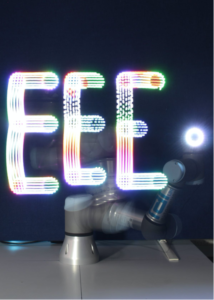Authors: James Male and Gorkem Anil Al
In the inte-R-action research lab, our focus is on trying to get humans and robots to work together in a natural and collaborative way. Focussed mainly on industrial applications, our work aims to get robots out from behind protective barriers where they perform the same actions repeatedly and into a shared workspace with humans. In order to get robots working effectively with humans (like a human may work with another human), they must be able to sense, perceive and act in a dynamically changing environment.
This leads into some of the key research projects within the int-R-action lab. Various novel sensors are being developed around the recognition of touch and gestures to help control the robot in a natural way. On top of this, vision and action recognition methods help build an understanding of what people in the robot’s environment are doing, allowing the robot to predict what actions it should perform in the future to best assist human workers. This collaborative approach to industry forms part of what is known as "Industry 4.0", leading on from previous industrial revolutions of mechanisation, mass production, digitisation. The key to Industry 4.0 being intelligent manufacturing giving mass customisation of products and highly efficient processes.
Given most of the research done is best illustrated in live demonstrations or videos of human and robot performing collaborative tasks together, when news of the departmental photo competition reached us the question was - how do we illustrate the dynamic nature of our research in a static photo? Being an avid amateur photographer, Gorkem had the idea of trying out a so called "light painting", where the long exposure captures the motion over time of lit objects against a dark background. A great idea, all that was left was the execution.
The main robot we use for research is a UR3 collaborative robot, a robotic arm with safety features that means it stops when force limits are exceeded making it safe to work around people. Attaching a bright LED ring to the end of the robot which flashed with various colours would allow the end of the robot to be tracked over time as the photo was taken. All that was left was to program the motion of the robot to spell out "EEE" (for Electronic and Electrical Engineering) and take the shot. This is easier said than done. The lighting had to be adjusted to ensure the E’s were vibrant without losing the robot in the background. While the shot was being taken, the timing of the robot, camera, LED lights turning off between each letter and a spotlight to illuminate the robot arm at certain points, took some practice to get right. After many blurred, over exposed, under exposed, half captured E’s and other weird shapes - success! One static illustration of the dynamic movements capable of robots for use in the future of manufacturing.

Respond
